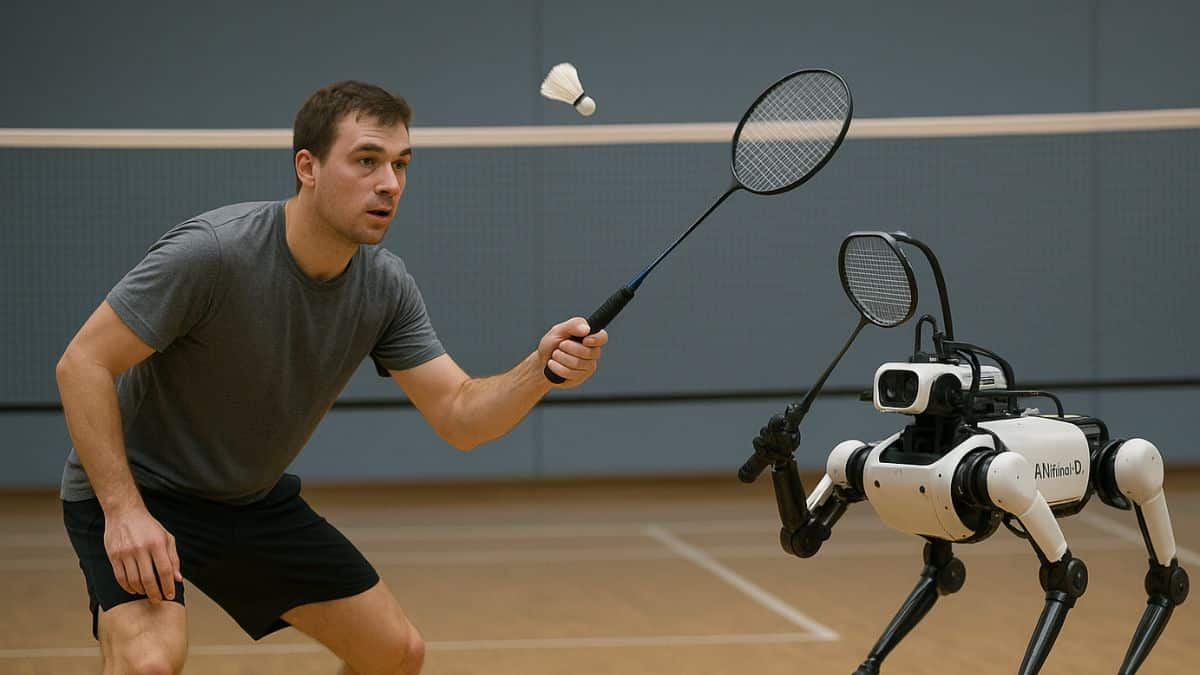The robotics world witnessed a remarkable breakthrough as ETH Zurich’s ANYmal-D robot demonstrated extraordinary capabilities on the badminton court. This quadrupedal marvel combines artificial intelligence with mechanical precision to challenge human players in ways previously thought impossible.
Revolutionary integration of perception and movement
ETH Zurich researchers have achieved what many considered a distant dream in robotics: seamless integration of visual perception and physical movement. The ANYmal-D represents a quantum leap in robotic agility through its reinforcement learning-based control system.
Traditional robots struggle with dynamic sports like badminton due to hardware limitations. Human eyes vastly outperform commercial robot cameras in tracking fast-moving objects. Yet ANYmal-D overcomes these challenges through innovative design.
The robot employs a unified reinforcement learning framework that allows it to track shuttlecocks traveling at speeds up to 40 feet per second. This perception-aware model accounts for motion-induced visual errors, significantly narrowing the gap between simulation and real-world performance.
According to lead researcher Yuntao Ma, “The controller’s end-to-end training optimizes the robot’s limbs for coordinated whole-body motion.” This approach creates a fluid integration between perception and action that makes the robot’s movements appear almost natural.
It’s staring right at us: AI reveals the Milky Way’s supermassive black hole is aimed directly at Earth
In China, a mountain range disappears under a sea of solar panels – creating the largest photovoltaic landscape ever deployed in the world
Inhuman reflexes on display
The ANYmal-D’s performance has stunned scientists and observers alike. In testing against human players, the robot consistently demonstrates remarkable agility, achieving rallies of up to 10 consecutive hits. Most impressively, it adjusts its gait based on timing and distance requirements.
The robot’s capabilities include:
- Real-time tracking and prediction of shuttlecock trajectories
- Autonomous adjustment of movement speed and direction
- Rising onto hind legs to maintain visual contact
- Balancing racket precision with whole-body stability
- Adapting to shots at various speeds and angles
When faced with challenging situations, the robot prioritizes balance and safety mechanisms to avoid falling while maintaining gameplay. This intelligent risk assessment represents a critical advancement in autonomous robotics.
The following table illustrates ANYmal-D’s performance metrics:
| Performance Metric | Value | Comparison to Humans |
|---|---|---|
| Maximum shuttlecock speed tracked | 40 feet/second | Moderate amateur level |
| Consecutive rally hits | Up to 10 | Beginner-intermediate level |
| System response delay | 0.375 seconds | 3-5x slower than elite human |
| Shot angle adaptability | High | Comparable to recreational player |
At 11 years old, she discovers a giant marine reptile that had been sleeping beneath our feet for 200 million years
They dumped 200,000 radioactive barrels into the Atlantic: French researchers launch an unprecedented mission to track them down
Technical limitations and future enhancements
Despite its impressive achievements, ANYmal-D faces challenges when competing against aggressive shots like smashes. The research team attributes these limitations to hardware constraints rather than algorithmic deficiencies.
The current system experiences an average delay of 0.375 seconds between the opponent’s shot and the robot’s first swing command. This latency significantly impacts the robot’s ability to intercept faster shots, particularly those requiring quick court repositioning.
Future improvements will focus on:
- Reducing perception-to-action latency through faster cameras
- Implementing additional sensing modalities beyond visual
- Enhancing actuator speed for quicker physical responses
- Developing more sophisticated prediction algorithms
- Expanding the training dataset for diverse shot patterns
The framework’s adaptability suggests promising applications beyond badminton. Researchers have already extended it to robotic throwing tasks and other dynamic movements requiring precise coordination between perception and physical action.
As this technology continues to advance, ANYmal-D represents more than just a badminton-playing robot. It demonstrates how integrated perception-action systems can transform robotics across multiple domains, from sports to potentially life-saving applications in search and rescue or medical assistance.
The implications of robots with human-like agility and precision extend far beyond the badminton court, opening new frontiers in human-robot interaction and collaborative environments where machines can respond dynamically to changing conditions.







